danbricklin.com/log
|
||
|
|
Starting February 3, 2009
Learning about indexes, Latest updates, AlertRank: Managing Google Alerts, The new meaning of transparency, Anybody have a Palm Zire Z22 for an Asperger's research and treatment project?, Recording of a fascinating class about the Passover Haggadah, The State of the Consumer Internet panel at the Vilna Shul, Tech Tuesday at NERD a big success, New essay from my book,Tech Tuesday at Microsoft in Cambridge next week, Something new coming from Dan - a book
03Feb09-24Mar09
2009_02_03.htm
|
|
|
Learning about indexes [link]
Getting my new book out has been an interesting learning experience. I've produced "books" before, mostly the manuals for my products, even to the point of doing all of the writing, layout, desktop publishing, and working with the printer. My manual for Dan Bricklin's Demo II was over 200 pages long, including several pages of a 3-column index in a very small font.
With "Bricklin on Technology" I get to see it from the side of a plain author that is working with a publisher. All those stories I've heard from other authors are ringing true in my head as I encounter the issues they all know so well.
Here's an example: As I wrote yesterday, I spent time last night looking over the index the publisher had created for them by a professional indexing person. I was very happy to not have to do an index myself -- it took up enough of my time just reading through the whole book again to check meaning and typos. The index, though, is the only major part of the book that I didn't write, or at least select. How do you "check" it? At first it seemed pretty simple: Just read down the columns and see if anything stands out. The copy I was working on already had some red notations, most of which were copy editing ("Al-Qaeda" has a hyphen, "PostScript" has a capital "S", etc.), so I got into that mindset. I saw "MacIntosh" under "Apple". That seemed strange. I checked -- yes, I was right. The official Apple trademark is "Macintosh" without the uppercase "I". My first "obvious" error to flag. (I had spelled it correctly in the book.)
Then I got to the section under the term "Blogger". Some of the items seemed strange: "debate about". I checked. This was a reference to a debate about the 2004 DNC bloggers, not the tool "Blogger". It should have been listed under "blogging". Oh, no. Now I have to look more closely at the description of items and the categories. I tried, but I don't know how well I did. (I was under a tight deadline -- the book is being sent to the printer in just a few days and the edits need to be completed by the "typesetter" before that.)
I got to an entry listed as "burning music". It had no page number, but said "See recording industry pirating issues". I think this came from burning CDs. That's not how I would have written it. First of all, I'd say "burning music CDs" (the entry is right after "Burning Man", which involves destroying something with fire). Second, I don't like using "piracy" as the "neutral" term in the index for a concept. As I pointed out (on page 59 of the book), using words like "sharing", "stealing", and "piracy" is a way of arguing for a position. My book tries to be more neutral on this topic, so calling it "piracy" here would not fit with the rest of my text. I flagged "recording industry pirating issues" in the index to be changed to "recording industry copying issues". Hopefully they'll all be changed appropriately.
Stuff involving laws, like copyright and patents, can be confusing. The item "touch-sensitive computer screens and" appeared under "copyright law". It should have been under "patents". I mentioned both at the beginning of a section in the book, but the following pages (the set of pages listed with the index item) are pretty much all about patents.
Looking this closely is hard, and I am sure that I missed a lot. On the other hand, at least most of it was pretty well done. Most people-names are in the index, and I have lots of them. Just a few errors -- mainly with people whose names end in "s", like Raikes, and where possessive forms in the main text may have confused things (and made them wrong there, too). I know how much my writing needs editing (it went through at least 5 copy editors in some cases for the book, and I still find errors that were in the original blog posts) and this index was pretty raw and had only been seen by one copy editor.
Yet again, I see how tedious it is to produce a book that doesn't have too many "glaring" errors. Sigh. Well, back to working on SocialCalc.
Latest updates [link]
Finishing up my book, Bricklin on Technology, has been taking up a lot of time. (I first wrote about it here early last month.) However, after spending a little time tonight looking over the index that the publisher created (22 pages long) I should be done. Each time I think I'm done doing a review of the main text, I get a new, "more final" copy back which needs to be checked. Last week I finished reading through something akin to galleys (all 475 pages of the main body) and I still found a few minor errors to report back that either I made or that were introduced in layout and other editing. Sigh. I'm told I should have a real, bound, printed copy in my hands in a little over a month, and you should be able to get it in stores very soon thereafter.
Having read through the whole thing, with the final layout, I'm pretty happy with how the book turned out and with what I chose to put in it. There are some great people who were kind enough to look over an earlier draft and give me quotes to put on the cover, including Ray Ozzie, Doc Searls, Joel Spolsky, and others. Now I have to wait another few weeks until people who don't know me read the real thing and I get to see what they say. I'd really appreciate people who know they want the book to order copies now from their favorite booksellers and post reviews as soon as they finish reading it. (If you plan to buy from Amazon, I'd doubly appreciate you buying through this link.)
Now I'm starting to figure out how I'm going to publicize the book when it's available. I'll probably do a book tour of some sort. I have a few speaking gigs set and will do more. Please be tolerant as I post all that here...
I've also been working a lot on SocialCalc for Socialtext. They've been busy releasing Socialtext Signals, a microblogging system tied into their commercial wiki system, and Socialtext Desktop, an AIR application that integrates Signals and other features of their system. (These things are really cool and I've also been spending time using them. If you are a Twitter user like I am -- @DanB -- you'll find Signals really comfortable.) Most of my work on SocialCalc has been polish, like an interactive list of functions to paste, and helping Socialtext integrate my new code into theirs. Beta testing is getting closer, but I don't know when.
AlertRank: Managing Google Alerts [link]
A company that I'm on the board of, Grazr Corp., just released a new service, AlertRank.com. It's generally interesting on two counts. If you use Google Alerts in your work you'll find AlertRank a real help and timesaver, as I'll explain below. If you are looking at different ways that people do mashups, it's also interesting, since it integrates through a wide range of Internet communication protocols.
Google Alerts are "email updates of the latest relevant Google results (web, news, etc.) based on your choice of query or topic." Basically, you give Google a normal search query and an email address. When Google's web crawlers find a new item that matches that query you are automatically sent an email with the page title, short excerpt, and URL of the page and parent web site. The subject line shows your query that matched. You can then manage the results in your email inbox or some other means. You have to decide if an alert is important to you or not. You can give Google Alerts multiple search queries and you will get emails for each. If you have multiple alerts and are tracking popular terms, it can get quite unwieldy.
When you sign up for Grazr's AlertRank service, you get a unique alertrank.com email address. You then change your Google Alerts to be sent to this new address. (Google lets you switch the email target easily.) When AlertRank receives the email from Google, it adds additional information before forwarding it on to you. That additional information gives you an indication of how "important" that alert is. It does this by showing the "AlertRank Quality Score" of the web site where the found page resides. The rank is a combination of Google Page Rank, Alexa Rank, and more. Here's an example:
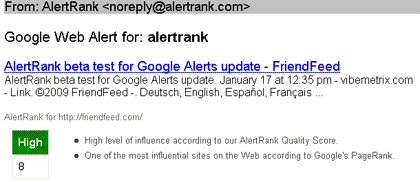 AlertRank also stores the alert in a database. Once a day it emails you a consolidated Excel-format spreadsheet listing all of the previous day's alerts, along with the other information it has about the web site, such as number of Yahoo! inbound links, whether or not the site is a blog and allows comments, and del.icio.us tags. At any point, you can log into the AlertRank.com service and view all your saved alerts and their details, not just from the one day. You can slice and dice them in various ways, including with an analytics page that gives you lots of interactive graphs.
Here are some screen shots:
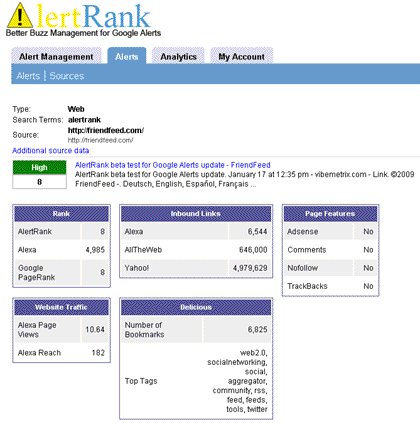 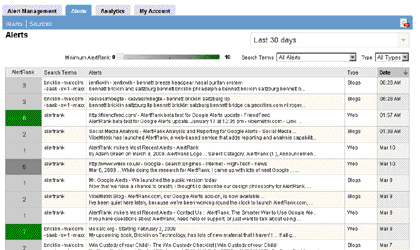 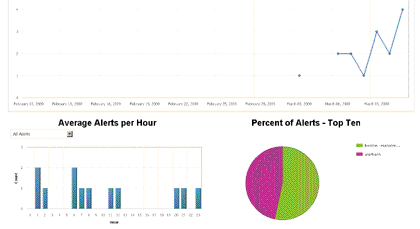 As part of managing your account with AlertRank, you can specify filters, such as that you only want to be sent emails when an alert is above a certain threshold in rank or only if the web site accepts comments. In any case, all alerts are stored and reported in the spreadsheet.
For more detail, you can start at their "How it Works" page.
Grazr charges a monthly fee for the AlertRank service, but have a 10-day free trial. If you are managing lots of Google Alerts I think it can save you a lot of time and do a better job tracking query hits, so hopefully it's worth the money. In any case, it's worth taking a look at.
From a developer's point of view, this is an example of an interesting use of an email proxy as a service, with additional data coming from a wide variety of sources.
In the process of working on this product, Grazr CEO Adam Green (well-known in the olden days as a dBase guru) has learned a lot about Google Alerts and shares what he's learning on a blog.
The new meaning of transparency [link]
I've just posted a new essay on my main web site: "The Meaning of Transparency in Today's Data-Centric World". While putting together my book I found various themes and ideas that come up in my writing. One is that you need flexibility for the unforeseen, and that the people who will need that flexibility are not always the people you anticipate. This especially came up in my "Learning From Accidents and a Terrorist Attack" essay. On a panel last week I presented my views of the new requirements for transparency as I see them using this principle. Afterwards, I was encouraged to write it up. Here it is.
Anybody have a Palm Zire Z22 for an Asperger's research and treatment project? [link]
A couple of years ago I wrote about a company that I've been involved with for many years, run by some close friends of mine, named SymTrend. They have software and a service that is used as an electronic diary for symptom tracking and reminding for treatment of ADHD, anxiety, depression, hormonal imbalances, and other situations. Recently their system has been used to help children with Asperger's Syndrome and anxiety disorder. For more information about SymTrend in general, see what I wrote back then, "My take on SymTrend: A way to track medical symptoms using a PDA or a web browser," and the YouTube video on that page that I made for them a year later.
Unfortunately, the mobile (non-web based) version of their data input system runs on the Palm operating system. They are coming out with an iPod Touch version, but it's not finished yet. The inexpensive Palm Z22 PDA seems to have become unavailable from Palm sooner than they expected (Palm announced that it was discontinuing it a while back). One of the research projects they are involved with at the University of Denver didn't pre-purchase enough units and is in desperate need of 10 Palm Z22s at either a reasonable price or for donation. If you have any, or know of anybody with one they don't need, please see this web page: "Desperate Need For Palm Z22 Handheld Computers!" Thanks!
Recording of a fascinating class about the Passover Haggadah [link]
Last year I took a 10-session course from Rabbi Reuven Cohn about the Passover Haggadah. The Haggadah is the book that is used during a Jewish Passover Seder that sets out the rituals, readings, and songs, and their order. The book, mainly in Hebrew, seems to be a random mishmash of different readings and blessings. With the help of the class I learned about its origins 2000 years ago by studying the ancient books of the Talmud, especially the parts called the Mishnah. Through the class I saw this book that I had been reading carefully for my whole life (and the ceremony it describes) in an entirely new light. I got to see its important place in the evolution of the Jewish religion after the destruction of the Second Temple in 70 C.E. It also helped give me some insight into the parallel development of Christianity at the same time.
I talked Reuven into giving a short version of the course (only about 5 hours) to some of my friends while I recorded it for sharing on the Internet (under a Creative Commons attribution, non-commercial, no-derivative works license). With the help of a few microphones and a PDF of the handouts, you should be able to feel as if you were there. The participants had a wide range of Jewish backgrounds, from very little Jewish education to extensive. The class was conducted in English.
Reuven is a very gifted teacher, with an interesting background. He received a law degree from Yale and once was a lawyer at a well-known Boston firm. He also received ordination from Yeshiva University and teaches at Hebrew College in Newton and Maimonides School in Brookline.
Passover is coming in two months, and I think many of my readers will find listening to this class worthwhile preparation for the Seders they may be attending (or leading). Others who are not planning to attend a Seder, but always wondered what the Talmud was all about, may also find it enlightening. If you have any Jewish friends, please let them know about it, including Jewish educators.
You can read a little more about the recordings on "About Reuven Cohn's Haggadah Recordings" and you will find the MP3 files themselves on www.reuvencohn.com. (The first half hour or so may be a little slow, but the class picks up as it gets into the text and gets very meaty by the end, so hang in there.)
The State of the Consumer Internet panel at the Vilna Shul [link]
Last night I attended another of Doug Levin's events at the Vilna Shul in Boston. This one was "The State of the Consumer Internet" which was billed as follows: "Today issues facing consumer Internet startups are very challenging. This panel consisting of thriving entrepreneurs will address customer acquisition, funding, startup and entrepreneurial dynamics, and other hot issues." The panelists were Brad Rosen, CEO of Drync, which has a wine-related iPhone app; Jeff Taylor, CEO, EONS, a web site for the Boomer-set, and Tributes, which tries to do for obituaries what his Monster.com did for Help Wanted ads; Scott Savitz, CEO of Shoebuy, a huge reseller of shoes online; and Dave Balter, CEO of BzzAgent, a word-of-mouth media network. The moderator was Jeffrey Bussgang of Flybridge Venture Partners.
I recorded a podcast. Some of the sound quality varies as people used the mikes differently, but there are some really good observations about how to run a business that depends upon getting users/customer on the Internet or iPhone.
You can find the recording on "State of the Consumer Internet panel at the Vilna Shul 2009-02-11".
Here are some photos:
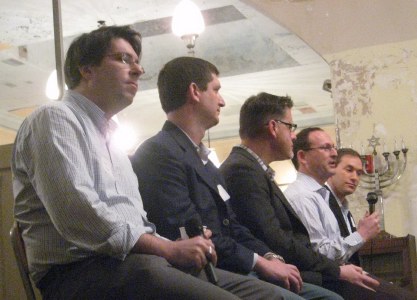 Dave Balter, Scott Savitz, Jeff Taylor, Brad Rosen, and Jeffrey Bussgang
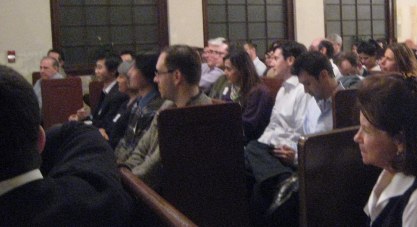 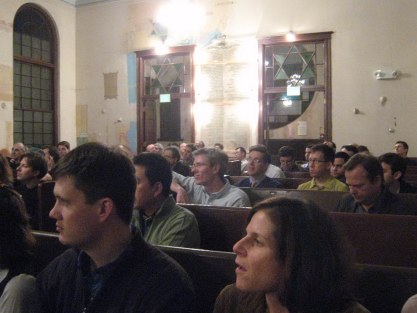 Tech Tuesday at NERD a big success [link]
Just got back from Tech Tuesday. It was at Microsoft's new R&D space in Cambridge, Massachusetts -- their New England Research & Development office: NERD for short. Microsoft is trying their best to be good local citizens and be a hospitable part of the local tech ecosystem. Tonight they sure succeeded. The space is big and comfy. There was lots of pizza, salad, and drinks. The first demos on the projector came from Philip DesAutels' Mac running Firefox. (Philip is a Microsoft Academic Evangelist and our host tonight.) It's OK to say "Google" -- another nearby large R&D group -- or Open Source without Microsoft people cringing. I think we'll see lots of events in this space.
We had a big turn out (over 200 signed up), with lots of students, CTOs, press, and more. Microsoft people did some short demos of Win 7, their Live Mesh framework, and app virtualization. Many people got to get up and give 30-second elevator pitches to ask questions or to say what they were working on. Carol Long of Wiley gave away a few hundred dollars worth of books (including one to Alan Lepofsky of Socialtext!), and Laura Fitton won the Zune raffle.
Here are some photos that show just some of the space:
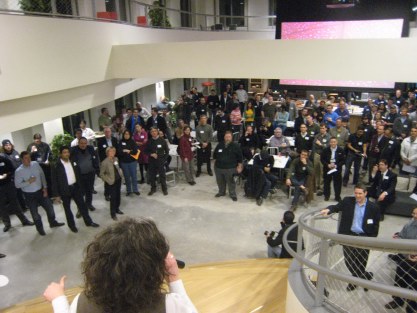 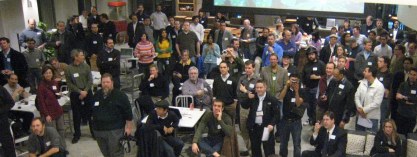 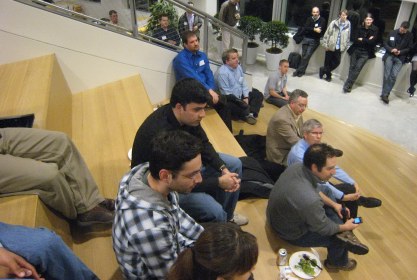 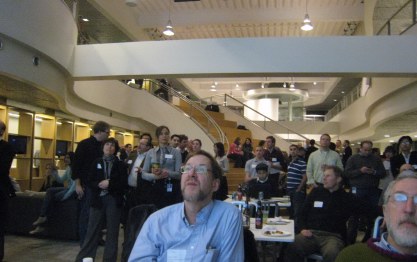 New essay from my book [link]
My upcoming book, Bricklin on Technology, has lots of new material that I haven't posted on the web. Much of it consists of introductory essays to some of the chapters (and the book itself), comments reflecting on what has transpired since the included essays or blog posts were written, and material to make the parts of each chapter flow together. At the end of writing the book I looked back and tried to tie it all somewhat together.
Late last December, while thinking about the various topics, including the story of the invention of the wiki, the creation of VisiCalc, the growth and acceptance of blogging, and essays like "What will people pay for?" and "Trust and cooperation cannot be surged," I came up with another simple observation and added it to that ending section. It is about how the individuals who create tools are inspired by an earlier experience or even a work of fiction. I then write a little bit of how the first Star Wars movie in 1977 has given us some visions, and about how some of those visions have played out when driven by what people really want.
I've posted a version of this as a new essay in my web site's Writings section. See "Turning Inspiration Into Our Own: May the Force Be With You...and You...and You."
Tech Tuesday at Microsoft in Cambridge next week [link]
I hate to drop back to another Tech Tuesday blog post, but I know that many of my Boston-area readers check here for updates. Also, for people who can't be there, Mass TLC President Tom Hopcroft blogs about meetings and often posts videos of parts of them, and hopefully he'll be able to capture a lot and this puts you on notice to look for those posts.
There will be a somewhat different type of Tech Tuesday meeting this month and it's very exciting. Instead of being out in Waltham, Microsoft is hosting it at their new R&D space at 1 Memorial Drive in Cambridge, Massachusetts. It's going to be in a big, open atrium-style space. They will be doing a short demo of the Windows 7 beta that is getting such glowing reviews, and you'll be able to do your own hands-on with it for those who don't want to sacrifice one of their own computers to testing. There's a room with XBoxes and plasma screens to play in. Many of their R&D people will be there (not just sales and marketing types) to talk about work they're doing in app virtualization, social media, and more. There will be a couple of touch-enabled computers with Win 7 to try. They are also giving away a Zune in some sort of raffle. Finally, they are providing pizza, and there will be drinks available (I'm not sure which drinks will be free and which not). There is not-too-expensive parking in the building, I'm told, and it's right near the Kendall Square T stop.
As usual, there will be lots of people to talk to who are not from Microsoft, cool videos and other demos, and more.
The Executive Acquisitions Editor at Wiley Technology Publishing, Carol Long, will be there. (They're the ones publishing my upcoming book.) She's bringing copies of some of their books, including Web Applications Hacker's Handbook and The Best of 2600: A Hacker Odyssey, some for giveaway. You can even look at the $90 Collector's Edition of the 2600 book (and maybe talk her into giving it away).
To sign up, go to the Mass TLC Tech Tuesday Event Page. It looks like this may reach the maximum capacity of the room, so sign up soon. It's free.
Something new coming from Dan - a book [link]
Longtime readers of my blog may have noticed that my frequency of writing has dropped off quite drastically last year. I'm averaging just a post or two a month, and most are about Tech Tuesday. I haven't posted a new essay since December 2007. Some of that can be explained by my ongoing work with Socialtext on SocialCalc and on some consulting, but not all. What's been happening is that I've been hard at work on another project that involves a lot of writing: A book. I finally have time to tell you about it.
In November of 2007, Joe Wikert, at the time a vice president at John Wiley & Sons, called me to see if I'd be interested in taking some of my web site material and using it to start a book. "Hey, it will be easy -- you've already written so much" was part of the pitch, I think. In late April, Executive Acquisitions Editor Carol Long and I finally finished and signed a book contract. I've been working on the book on and off ever since, and as anybody who's written a book knows, it's an awful lot of work. It is finally now pretty complete, and is in final edit and layout at Wiley. If all goes well, you should be able to get a copy of "Bricklin on Technology" by the beginning of May. (You can pre-order it now wherever you buy books -- the ISBN is 978-0-470-40237-5.)
It was an interesting and different experience. After a decade of periodic essays on topics of interest to me at the moment -- blogging, and documenting things chronologically -- I got to step back and try to clarify, organize, and make use of that raw material.
This is not a book about blogging (though you'll learn a lot about blogging from reading it), nor just a "best of Dan" anthology. On the web site I cover many areas, from theories about computer network architecture to the joy of walking through crunchy multi-colored leaves in the New England fall. Two important themes in my writings, though, are the human aspect of the development and use of technology, and the evolution of that use. The book is the result of extracting those few themes, reordering and regrouping the material from its original chronological progression, and embellishing the raw material with commentary and new observations. The result is, hopefully, a presentation in a more coherent and useful fashion.
I tried to make sure that the book would be understandable and interesting to a more general audience than my blog -- you don't have to know what HTML or HTTP are to read it. I want my family and friends to understand and enjoy it (and your family and friends, too, if you think there's any message in it that you want to share).
For others who have been blogging for many years and are contemplating a book, this will hopefully be an interesting attempt from which you can learn lessons (both good and bad).
Much of my material was originally written to stand on its own without regard to flowing cleanly into the next piece, which is one of the important properties of a blog and web site like mine. Things are presented as chunks: single web pages, blog posts, or recordings. They are linked to each other and to other pages and posts on the web, but the order of reading was never fixed, except perhaps chronologically in the order in which they were written. On the web, most people read only one piece at a time, either because they are following my writings on a daily or weekly basis, or, more commonly, because they are directed to that particular piece by a link on somebody else's web writing, through an email, or as the result of using a search engine. Everybody reads a different set of pieces of the material and in a different order.
A book is different. It has a definite preferred order, and you expect people to go from one page directly to the next with few pauses. In the book, I found an order that follows the major theme of each piece and strings them together into a logical whole. I add footnotes and other material to fill in gaps, explain technical or obscure terms, and put the material in context. (It turned out that, while I had already written a lot, there was lots more to write to make it the book that I wanted it to be.) I use some simple layout and typographic styles to make what I'm doing clearer without resorting to a huge coffee table-sized book to deal with the "hypertextness" of the material (which was my first thought).
In the book, thanks to the generous permission of dozens and dozens of people, I include some of the material to which my writings are a reaction and also some of the reactions that are in response to my writings. In addition to putting what I write in a fuller context, it will also give the reader a better feel for the give and take that a blog writer gets with the community made up of readers. I tried hard to maintain the "feel" of blogging, and include lots of photos and illustrations. To get the feel for podcasting, I've also included transcripts of a few of my interviews that are relevant to the topic at hand.
Over the next few months, while waiting for Wiley to finish their part of the work, I'll write more about the book, what the process was like, and post some of the new material that I wrote for it.
|
||
|
© Copyright 1999-2018 by Daniel Bricklin
All Rights Reserved.
See disclaimer on home page.
|
||